Category Archives: The Red Folder
Prize-winning astronomy image, the ultimate cost of Cassini, amazing facts about lasers
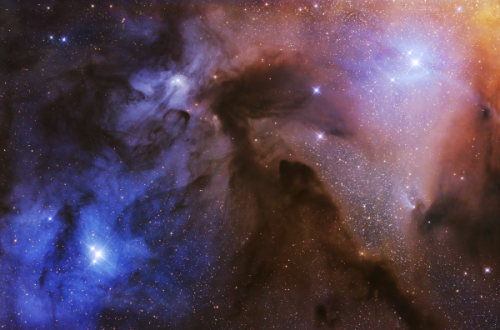
Prize winning: the Rho Ophiuchi Cloud Complex captured by Artem Mironov (Courtesy: Artem Mironov)
By Hamish Johnston and Michael Banks
Hats off to the Russian photographer Artem Mironov, who has beaten thousands of amateur and professional photographers from around the world to win the 2017 Insight Astronomy Photographer of the Year. The award is in its ninth year and is run by the Royal Observatory Greenwich together with Insight Investment and BBC Sky at Night magazine. Mironox’s image, which was taken over three nights from a farm in Namibia, is of the swirling dust and gas clouds in the Rho Ophiuchi Cloud Complex. The object is situated approximately 400 light years away from Earth and is home to a cluster of more than 300 protostars. As well as winning the £10,000 top prize, Mironov’s image will be on display along with other selected pictures at an exhibition at the Royal Observatory that will run until 28 June 2018. The competition received over 3800 entries from over 90 countries. (more…)
View all posts by this author | View this author's profile
A punt on Planck, physicist puts Frankenstein to music, would Brian Cox cope on Mars?
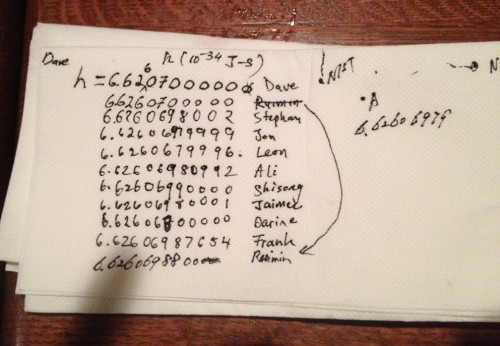
Fancy a flutter? The NIST napkin. (Courtesy: NIST)
By Hamish Johnston
A paper napkin with a load of numbers scrawled on top has been an unusual source of excitement for physicists at the US National Institute of Standards and Technology (NIST) in Gaithersburg, Maryland. One evening in December 2013, a group of them had gathered at a local watering hole to celebrate the success of NIST’s latest watt balance – NIST-3 – that had just determined Planck’s constant to a new accuracy. While enjoying “happy hour”, NIST researcher Dave Newell pulled out a napkin and the 10 researchers began to write down their predictions for the final value of Planck’s constant that NIST would submit to the International Bureau of Weights and Measures in Paris to help redefine the kilogram. The researchers then sealed the napkin in a plastic bottle and buried it inside a cavity within the foundation of NIST-3’s successor NIST-4, which was then being constructed.
View all posts by this author | View this author's profile
The sounds of Saturn, dancing particles, distracted funding agency
By Hamish Johnston
Astronomy can be a highly visual science and therefore developing ways of sharing data with visually impaired colleagues – and the public – is an important challenge. Sound offers one way forward, as astrophysicist Wanda Diaz Merced explains in “The sounds of science”. Now, fellow astrophysicists Matt Russo and Dan Tamayo at the University of Toronto have converted the motions of the rings and moons of Saturn into two musical compositions. You can listen to a composition based on the orbital frequencies of moons and rings by playing the video above. The second piece is called “Resonances of Janus translated into music”.
View all posts by this author | View this author's profile
Spacesuit of the future, another ancient Pythagoras, Disney’s football analysis
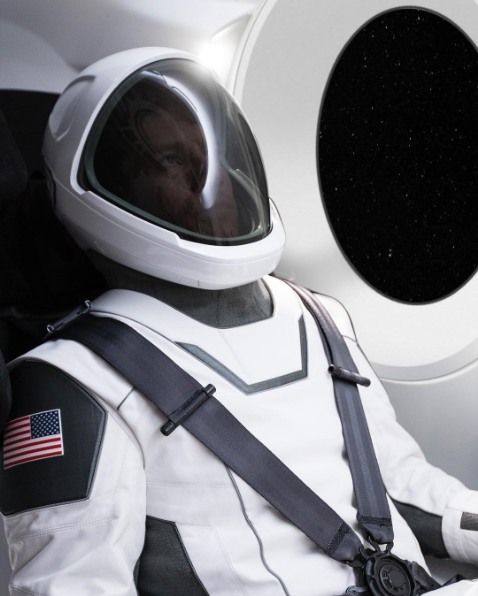
The stuff of movies: new SpaceX suit could be in a film (Courtesy: SpaceX)
By Sarah Tesh and Michael Banks
Astronauts on board the SpaceX Dragon Capsule will look like they’ve stepped out of a sci-fi film. This week, Elon Musk revealed his company’s futuristic space attire on Instagram. The suits are aesthetically very different to the bulky gear NASA astronauts currently wear, the Extravehicular Mobility Unit (EMU). They are even sleeker than NASA’s next generation Z-2 suit, which was previewed in 2015. The SpaceX garb are apparently also easier to walk in and more practical for everyday use. While not quite at the tech standard of fiction, the SpaceX suits definitely look the part.
View all posts by this author | View this author's profile
Indian independence, Doppler effect on a train, contagious science
By Michael Banks
This week India celebrated 70 years of independence. So what better way to mark the occasion than a music video? Step forward 20 or so scientists from the Indian Space Research Organisation (ISRO), who dub themselves the Rocket Band. Over the space of 18 months, they worked feverishly to create a seven-minute music video entitled “I am an Indian”. Mostly shot on the coast of the Arabian Sea, the video features the researchers walking along the beach as well as an animation of the Indian flag being put on the surface on the Moon. “We have a lot of talent in ISRO, making rockets comes naturally to many of us while making music is tough but it is not rocket science,” aerospace engineer Shiju G Thomas told NDTV.
View all posts by this author | View this author's profile
Ancient eclipse art, asteroid finds early fame, unwitting face of graphene underwear
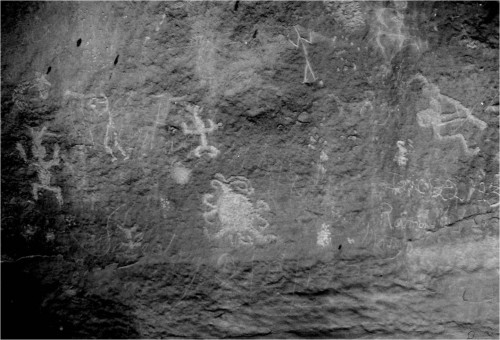
Ancient eclipse: a Chaco Canyon petroglyph (Courtesy: University of Colorado)
By Sarah Tesh, Matin Durrani and Michael Banks
The approaching total solar eclipse on 21 August is the subject of much interest and excitement — but the Earth has of course been in and out of the Moon’s shadow since it formed. While we have the technology to take spectacular photos of the corona framing the Moon, our ancestors were limited to much cruder means of recording such events. For example, the ancient petroglyph (a carving in rock) shown above may represent a total eclipse that occurred in 1097. The carving is on a free standing rock known Piedra del Sol in New Mexico’s Chaco Canyon. “I think it is quite possible that the Chacoan people may have congregated around Piedra del Sol at certain times of the year and were watching the sun move away from the summer solstice when the eclipse occurred,” says solar physicist J. McKim Malville from the University of Colorado, Boulder in the US, who focuses on archaeoastronomy. Other nearby carvings may be related to the 1054 supernova and the passing of Halley’s Comet in 1066. “The appearance of the spectacular supernova and comet may have alerted the residents of the canyon to pay attention to powerful and meaningful events in the sky,” says Malville. Hopefully our records of astronomical events will be as long lasting as those of the Chacoan people.
View all posts by this author | View this author's profile
Happy birthday Curiosity, overpaid footballers, cheeky Einstein photo sells
By Sarah Tesh, Hamish Johnston and Michael Banks
It’s Mars Curiosity’s 5th birthday tomorrow! The NASA rover touched down on 5 August 2012 and has been exploring the red planet ever since. It has travelled more than 10 miles, studied more than 600 vertical feet of rock and even proved that Mars was once habitable. While a Mars birthday party for Curiosity would be a lonely affair, researchers at NASA Goddard Space Flight Center have programmed the rover to sing “Happy birthday” to itself using its Sample Analysis at Mars (SAM) instrument. To introduce ground samples into the rover, SAM resonates through a range of frequencies, so the researchers programmed the instrument to run through the frequencies of the celebratory song.
View all posts by this author | View this author's profile
Ravens at LIGO, stained-glass physics, fake space pics

Grand designs: Los Alamos physicist Hubert van Hecke combines his hobby of stained-glass windows with physics. (Courtesy: Hubert van Hecke)
By Michael Banks and Sarah Tesh
Researchers working on the Laser Interferometer Gravitational-Wave Observatory might be answering some of the biggest questions in astrophysics, but last week they had a rather more down-to-Earth problem to solve. When spurious glitches were picked up by the detector characterization group at the LIGO detector based in Hanford, Washington, they went on an investigation to find the culprit. The team suspected that ravens were to blame as they had been seen causing mischief on tubes that vent nitrogen gas. These pipes are connected to the vacuum enclosure and any vibration could change the optical path length of light that is scattered from the test mass and reflected back. Upon closer inspection, LIGO researchers found peck marks that were “consistent with the size of a raven’s beak”. Not content with just watching the birds at play, the team even performed “simulated pecking” to see how this affected the machine’s performance. With the culprit now identified, you will be pleased to hear that the lines are set to be insulated to fend off the birds. “I guess we can’t blame [the ravens] for desiring ice on a hot desert afternoon,” writes Robert Schofield in a LIGO logbook post.
View all posts by this author | View this author's profile
The Doomsday Clock ticks over 70 years, an exoplanet Westeros
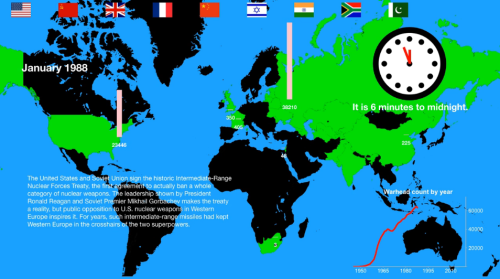
Circa 1988: the Doomsday Clock during safer times. (Courtesy: The Bulletin of the Atomic Scientists)
By Hamish Johnston
This year marks the 70th anniversary of the Doomsday Clock that is produced by The Bulletin of the Atomic Scientists. Currently at two and a half minutes to midnight, the clock represents the likelihood of a human-caused global catastrophe. Originally, it focused exclusively on a nuclear Armageddon, but in 2007 climate change and other technologically-driven processes were added to the mix. The clock was initially set at seven minutes to midnight in 1947 and the Bulletin has produced a video that charts the ups and downs over the past seven decades. Is there any good news? In the image above you can see that South Africa was a nuclear power in 1988, and it has since disarmed.
View all posts by this author | View this author's profile
Snapping the Milky Way, art inspired by SLAC blueprints, doppelganger magazine covers
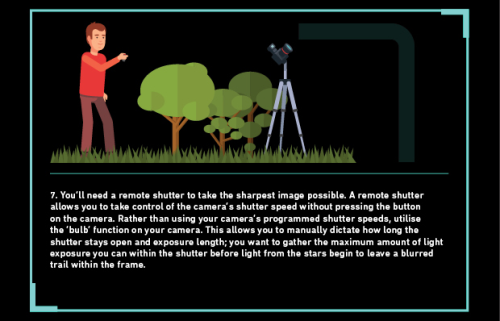
Top tip: use a remote shutter control. (Courtesy: Clifton Cameras)
By Hamish Johnston
If you are lucky enough to live somewhere with dark skies, you know that the Milky Way is a truly majestic sight. But how exactly would you go about capturing its magnificence with a camera? UK-based Clifton Cameras has put together an infographic with a few helpful hints. The image above is an excerpt and you can view the entire infographic here.
View all posts by this author | View this author's profile